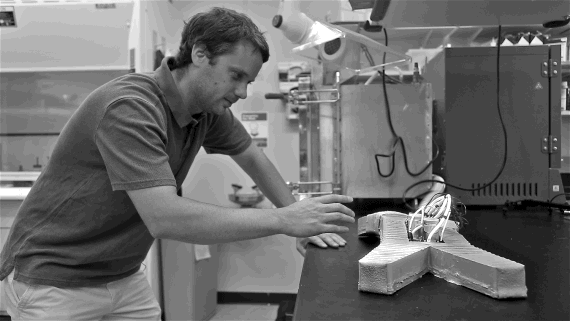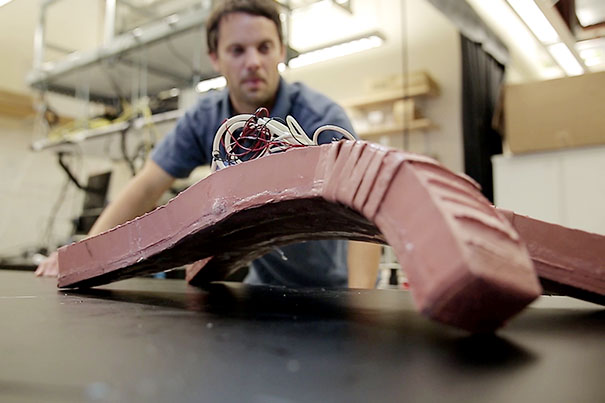This robot may not look all that intimidating at first glance, but beware — is is as resilient as they come. A group from Harvard University’s Whiteside Research Group has unleashed their latest indestructible design upon the world: pneumatically-powered, fully-untethered mobile soft robot. In other words, a quadruped that can stand up and walk away from its designers.
In the original design, a tethered air compressor created this robot’s mass; while, the newest iteration of the crawler possesses an internal compressor that inflates the silicone skin. With more parts being incorporated inside the design’s silicone shell, there is little that can slow down this amorphous android.
The prototype’s design encompassed a complete set of functional elements — including body, power source, control system, and sensors.
“The body of our soft robot consists of four legs connected to a central body, each of which is actuated by a Pneu-Net, in a configuration identical to our previous, tethered quadrupedal soft robot design. In order to increase the rate of actuation of the larger untethered robot, we used a Pneu-Net design that allows for actuation at lower pressures, and with less volumetric flow of gas into the Pneu-Nets, than our prior design,” the researchers note. “The spine of the robot is actuated by two parallel Pnet-Nets with space between them to accommodate the power supply, control board, and two air compressors.”
The soft robot measures in at 25.6-inches, significantly larger than its predecessor. The silicone shell housing the unit has been tested at sub-zero temperatures, 40 km/h winds and 3,000 degree kelvin flames for up to 50 seconds. That’s almost 5,000° F! Researchers have even the robot in snow, submerged it in water, walked it through flames, and ran it over with a car. Oh, and this little fellow is resistant to acid, in case you thought you had a bright idea on how to discourage him. After every single experiment, it emerged unscathed.
According to the report, a custom, lightweight board was designed to control the mini air compressors and solenoid valves that actuate the soft robot. An ATmega168 MCU on the controller board with an Arduino bootloader was used for uploading, storing, and executing programs to control the soft robot. Control programs were stored in the onboard memory of the controller.
“These programs, written and uploaded using the Arduino interface, consisted of sequences of commands to the control valves and air compressors. The extent of actuation of a Pneu-Net was controlled by the duration that the valve connecting it to the source of pressurized gas was opened,” the report states.
What does this device mean for the technology community as a whole? This innovation by the team at Harvard is ushering in a new era of autonomous robots. Could you imagine strapping a GPS locater and camera to this crawling unit and exploring areas that are uninhabitable by humans? As with all Atmel powered gadgets, the possibilities are truly endless. As the materials become stronger and the production becomes further internalized and streamlined, an army of these soft robots could be in the field in the coming years.
“Earlier versions of soft robots were all tethered, which works fine in some applications, but what we wanted to do was challenge people’s concept of what a robot has to look like,” said Michael Tolley, co-author of the report and a Research Associate at Wyss Institute. “We think the reason people have settled on using metal and rigid materials for robots is because they’re easier to model and control. This work is very inspired by nature, and we wanted to demonstrate that soft materials can also be the basis for robots.”
Read the Harvard team’s entire publication here.


